| Karkee Web Home Page | Pattern 1958 Home Page | Patt. '58 Components Page |
Web Equipment, Pattern 1958 - Components
Belts, Straps, & Yoke
Stores Ref. CN 0025 BELT, WAIST, MK.1, NORMAL
Stores Ref. CN 8465-99-973-6217
 Made from 2 ¼-in. beaded-edge, flat-loop belting, exactly as for Patt. ’37 W.E., the flat-loops only served to locate the “C” hooks of attached components. Instead, the U.S. form of centre-line adjustment was chosen, with a line of eyelets / grommets extending for a distance on each side, the Belt ends fitted with a simple hook held in thin web patching over the cut ends of the belting. In all fairness, the U.S. method, first pioneered by Mills, did afford a quicker and easier adjustment. The buckle was the old “hook and loop” type, but made in anodised aluminium. Otherwise plain, two narrow webbing chapes held metal dees disposed symmetrically on the outside rear, oriented downwards from the lower Belt edge. These served as attachment points for the Cape carrier. Waist sizes up to 40 inches were accommodated. In the 1965 C.C.N. Section CN, the nomenclature of Belt, waist, normal was italicised as obsolescent. From the Rog Dennis Collection. Photographs © Rog Dennis, 2012.
Made from 2 ¼-in. beaded-edge, flat-loop belting, exactly as for Patt. ’37 W.E., the flat-loops only served to locate the “C” hooks of attached components. Instead, the U.S. form of centre-line adjustment was chosen, with a line of eyelets / grommets extending for a distance on each side, the Belt ends fitted with a simple hook held in thin web patching over the cut ends of the belting. In all fairness, the U.S. method, first pioneered by Mills, did afford a quicker and easier adjustment. The buckle was the old “hook and loop” type, but made in anodised aluminium. Otherwise plain, two narrow webbing chapes held metal dees disposed symmetrically on the outside rear, oriented downwards from the lower Belt edge. These served as attachment points for the Cape carrier. Waist sizes up to 40 inches were accommodated. In the 1965 C.C.N. Section CN, the nomenclature of Belt, waist, normal was italicised as obsolescent. From the Rog Dennis Collection. Photographs © Rog Dennis, 2012.
Stores Ref. CN 0026 BELT, WAIST, MK.1, LARGE
Stores Ref. CN 8465-99-973-6218 BELT, waist, large
Stores Ref. CN 8465-99-973-6218 BELT, WAIST, drab, large Mk. 1

 Waist sizes from 37- to 46-inches were accommodated, the Belt being otherwise identical to the Normal size. The Belt illustrated formed part of the set which had the “POUCHES, REAR, SUBSTITUTE”, illustrated under User Mods at "Pouches, Rear, Substitute". Note the extensive compression of the upper beaded edge. This was where the concertina’d fairlead of the Respirator haversack was located. From the Rog Dennis Collection. Photographs © Rog Dennis, 2012.
Waist sizes from 37- to 46-inches were accommodated, the Belt being otherwise identical to the Normal size. The Belt illustrated formed part of the set which had the “POUCHES, REAR, SUBSTITUTE”, illustrated under User Mods at "Pouches, Rear, Substitute". Note the extensive compression of the upper beaded edge. This was where the concertina’d fairlead of the Respirator haversack was located. From the Rog Dennis Collection. Photographs © Rog Dennis, 2012.
Stores Ref. CN 0027 Un-used.
CN 0027 was never allocated, being presumably left vacant, perhaps for an Extra Large Belt, if one proved necessary.
Stores Ref. CN 8465-99-120-7155 BELT, Waist, Adjustable
Stores Ref. CN 8465-99-120-7155 BELT, WAIST, olive, drab
 In the 1965 C.C.N. Section CN, the Belt, waist, normal being shown as obsolescent, a new Belt had been added, with waist accommodation from 27- to 38-inches. It seems a pointless change, there being no other differences, so it is assumed that parsimony demanded shorter Normal Belts, thus saving on materials! Rather usefully, this example has massive stencilling, which has not rubbed off, as is the case with most used Belts. From Terry Hawker Collection. Photographs © Terry Hawker, 2012.
In the 1965 C.C.N. Section CN, the Belt, waist, normal being shown as obsolescent, a new Belt had been added, with waist accommodation from 27- to 38-inches. It seems a pointless change, there being no other differences, so it is assumed that parsimony demanded shorter Normal Belts, thus saving on materials! Rather usefully, this example has massive stencilling, which has not rubbed off, as is the case with most used Belts. From Terry Hawker Collection. Photographs © Terry Hawker, 2012.
 This is a lightly used example, retaining some of its markings, sufficient to see the N.I.I.N. of 120-7155. From the Rog Dennis Collection. Photographs © Rog Dennis, 2012.
This is a lightly used example, retaining some of its markings, sufficient to see the N.I.I.N. of 120-7155. From the Rog Dennis Collection. Photographs © Rog Dennis, 2012.
Stores Ref. CN 8465-99-869-3247 BELT, WAIST, Size, Medium
Stores Ref. CN 8465-99-869-3247 BELT, WAIST, Size, Large
Stores Ref. CN 8465-99-869-3248 WAIST BELT LARGE, 58 PATTERN & / OR WORKING DRESS

 This was introduced between the 1993 and 1995 editions of C.O.S.A. Section CN, being listed for the first time in the latter edition, but which vanished by the 1999 edition. C.O.S.A. The Detail column added Nylon, IRR; 58 Pattern Equipment, which gives no clue as to what its purpose was. The Mark 2 Pattern 1958 had not been adopted, so this Belt is a “stand-alone”, with little apparent purpose, as no other components of ’58 were IRR, i.e. Infra Red Reflective. The clue therefore lies in the third sub-title above, which is taken from the label on an actual example, coincidentally manufactured in 1999.
This was introduced between the 1993 and 1995 editions of C.O.S.A. Section CN, being listed for the first time in the latter edition, but which vanished by the 1999 edition. C.O.S.A. The Detail column added Nylon, IRR; 58 Pattern Equipment, which gives no clue as to what its purpose was. The Mark 2 Pattern 1958 had not been adopted, so this Belt is a “stand-alone”, with little apparent purpose, as no other components of ’58 were IRR, i.e. Infra Red Reflective. The clue therefore lies in the third sub-title above, which is taken from the label on an actual example, coincidentally manufactured in 1999.
It replaced the Belt, working, which had no stores code, being cut from rolls of stiff, flat, nylon webbing, with added nylon Keepers (Slides) and a ’58 “hook & loop” buckle. It was quite the most “naff” piece of kit the Army had ever had! It looked and felt nasty and came with an equally nasty Frog, bayonet. Since neither were designated as “Patt. ‘58”, they have been omitted from this account.
This replacement Belt was of identical weave and construction to cotton “flat loop” belting material, complete with a beaded edge, albeit a narrow one. Blackened brass End Clips with “C” hooks were used for adjustment, as with Patt. ’37 Belts and a blackened brass “hook & loop” buckle, with slides were fitted. The rear of the Belt had narrow external nylon chapes, with rectangular metal loops, in place of the “D” shaped versions on Patt. ’58 cotton Belts. It was, in all respects, a much more presentable Belt, but the nomenclature should not have included “58 Pattern”. It was still very stiff and, in due course, a softer version, in a lighter green colour was introduced. From the Rog Dennis Collection. Photographs © Rog Dennis, 2012.
Stores Ref. Not applicable BELT, WAIST, ROLL-PIN (Commercial)

 User-mod Roll-pin Waist-belts are covered elsewhere, but this example is evidently not a conversion of a Patt. ’58 Belt, in that the centre-line adjustment eyelets are fitted only on the left side. The material for the Belt is the usual beaded-edge, flat-loop belting normally used. Although marked as “L” (for Large), the Broad Arrow is far larger than might be expected, suggesting it might be an “enhanced” commercial offering. These items are marketed to the target group of “…professional soldiers…”. Whilst it undoubtedly is an improvement on the alloy “hook and loop” buckles and it is “quick-release”, it has to be threaded up, not forgetting it has to be un-threaded before the Belt can be completely removed.
User-mod Roll-pin Waist-belts are covered elsewhere, but this example is evidently not a conversion of a Patt. ’58 Belt, in that the centre-line adjustment eyelets are fitted only on the left side. The material for the Belt is the usual beaded-edge, flat-loop belting normally used. Although marked as “L” (for Large), the Broad Arrow is far larger than might be expected, suggesting it might be an “enhanced” commercial offering. These items are marketed to the target group of “…professional soldiers…”. Whilst it undoubtedly is an improvement on the alloy “hook and loop” buckles and it is “quick-release”, it has to be threaded up, not forgetting it has to be un-threaded before the Belt can be completely removed.
A length of 2-inch webbing, with a Tip, brass, 2-in. – a venerable Mills item – is stitched to the outside, on the right hand side of the Belt. The latter’s cut end is protected by doubled thin webbing, as is normal, but without the integral adjustment hook. The left-hand section is doubled back as usual, with a slide, but in place of the usual loop half of a “hook and loop” buckle, a brass-plated friction-lock buckle - of the kind used on Straps, securing, Airborne freight is fitted.
This buckle is widely known as a “roll-pin” – the one thing it does NOT do!! Whilst free to move, it does so in-line with the buckle frame, the pin having grooved ends to facilitate this, which ensures it cannot rotate. A roll-pin buckle is more properly the type used on trouser belts, initially in the U.S. forces during the last war (earlier?), but which the R.A.F. were using by 1966. To facilitate a quick-release, a plate is bent around the outer vertical bar and riveted in place. This is slotted, as a short webbing lift-tab is usually fitted onto load straps. The technical term for this type of buckle has yet to be determined. Any reader…?
The rear of the belt has the standard metal loops for the Carrier, cape. Thus far, no photograph, of an assembled set of Patt. ’58, has been seen on any soldier. It is more likely that it is used as a trouser belt. From the John Bodsworth Collection, photographs © John Bodsworth 2012.
Stores Ref. CN 0033 STRAP, UTILITY, MK. 1
Stores Ref. CN 8465-99-973-6224 STRAP, Webbing, utility
 This was a simple ¾-in. Strap, 18-inches long, with a buckle at one end and a crimped-on tip at the other. These last were a direct crib of the U.S. component, but fixed in place by a centre-punched indentation on back and front. As might be expected, they pulled off far too easily in use! From the Rog Dennis Collection. Photographs © Rog Dennis, 2012.
This was a simple ¾-in. Strap, 18-inches long, with a buckle at one end and a crimped-on tip at the other. These last were a direct crib of the U.S. component, but fixed in place by a centre-punched indentation on back and front. As might be expected, they pulled off far too easily in use! From the Rog Dennis Collection. Photographs © Rog Dennis, 2012.
Stores Ref. CN 8465-99-120-7159 STRAP, Webbing, utility, Modified [Issue 2]
Stores Ref. CN 8465-99-120-7159 Strap, Webbing, Utility, 18" long with buckle and tab [Issue 2]
Stores Ref. CN 8465-99-120-7159 STRAP, Webbing, utility, 18 in. lg, 3/4 in. w [Issue 2]
 Still ¾-in. by 18-inches long, the crimped tips were replaced by a standard Mills eyeletted tips. Surprisingly, the Army gave it a new code, where their “Form, Fit & Function” attitude more often gave an identical code to very different variations of a component part. From the Rog Dennis Collection. Photographs © Rog Dennis, 2012.
Still ¾-in. by 18-inches long, the crimped tips were replaced by a standard Mills eyeletted tips. Surprisingly, the Army gave it a new code, where their “Form, Fit & Function” attitude more often gave an identical code to very different variations of a component part. From the Rog Dennis Collection. Photographs © Rog Dennis, 2012.
Stores Ref. CN 0029 YOKE, MK. 1
Stores Ref. CN 8465-99-973-6225 YOKE, FIELD PACK
 This one item represented the longest gestation period ever! Mills had patented a Yoke support in 1906. It actually was drawn as a support to the waist belt of Valise Equipment, Pattern 1882! In the event, not one Mills design ever used the concept. When the U.S. introduced their M-1956 LCE, it was the very first use of such a Yoke, anywhere in the world. It has some resonance with the Harness, Carrying, Infantry, G.S., but it is not known if this was the inspiration. The Patt. ’58 design was also quite the best shoulder support that the British Army had ever seen, having a huge bearing surface, which was also padded. From the Rog Dennis Collection. Photographs © Rog Dennis, 2012.
This one item represented the longest gestation period ever! Mills had patented a Yoke support in 1906. It actually was drawn as a support to the waist belt of Valise Equipment, Pattern 1882! In the event, not one Mills design ever used the concept. When the U.S. introduced their M-1956 LCE, it was the very first use of such a Yoke, anywhere in the world. It has some resonance with the Harness, Carrying, Infantry, G.S., but it is not known if this was the inspiration. The Patt. ’58 design was also quite the best shoulder support that the British Army had ever seen, having a huge bearing surface, which was also padded. From the Rog Dennis Collection. Photographs © Rog Dennis, 2012.
In the 1970s, I challenged Karrimor about the inadequacies of their 2-inch shoulder straps on my “H” frame Tot-Em Pack, even with their separately sold shoulder pads. I pointed out the Norwegian firm of Bergans (note the spelling) offered triangular padded attachments, with paired buckles and straps. These could be attached to adjacent upper / lower cross-bars, thereby angling the pad more to the slope of the shoulders. The narrow straps from the pack base then attached to a Q.R. buckle on the pad.
Karrimor responded that the new Army pattern utilised tubular nylon webbing, 2.5-inches wide in the flat, which became 2-inches when filled with foam. They were actually describing the experimental Patt. 1975 P.L.C.E., which was not adopted. What a cop-out response and the Ski Rucksack they supplied to the Army had the same inadequate 2-inch shoulder straps. Ah well, I tried. If they’d listened, I might have caused the Army to receive something more serviceable, at a time when they were beginning to turn to the clothing and equipment we mountain walkers had been using for years!!
In form, the Yoke was much akin to that of a milkmaid’s wooden version. A padded trapezoid lay just behind the shoulders, clear of the neck, with two angled shoulder strap flares stitched to this and terminating in mitred ends on the upper chest. A pair of 1-in. wide, vertical straps were stitched into the rear of the Yoke. The ends were doubled back, through metal links, to 1-in. buckles, which adjusted the length. The metal link was attached to a pad, on which a pair of 2.25-in. “C” hooks were stitched. This arrangement was near identical to the belt attachment of Patt. ’44 Brace attachments.

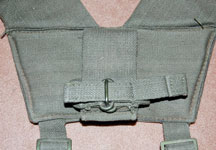
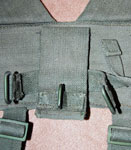 Far left - A long 1-in. strap was attached to the front, where the Yoke flares tapered-down. This was combined with a semi-circular loop (above) and a Q.R. buckle, with lifting tab below. The strap was doubled through the metal loops on the Ammunition pouches and brought back to the Q.R.B., where its length was easily adjustable, a feature not present on Patt. ‘44 W.E.. Centre left - Centrally, on the pad behind the shoulders was a spigot carrier, the spigot being the male part of an LTD fastener. Near left - The Carrier was fashioned from 2-in. webbing, stitched at its lower end and extending upwards.
Far left - A long 1-in. strap was attached to the front, where the Yoke flares tapered-down. This was combined with a semi-circular loop (above) and a Q.R. buckle, with lifting tab below. The strap was doubled through the metal loops on the Ammunition pouches and brought back to the Q.R.B., where its length was easily adjustable, a feature not present on Patt. ‘44 W.E.. Centre left - Centrally, on the pad behind the shoulders was a spigot carrier, the spigot being the male part of an LTD fastener. Near left - The Carrier was fashioned from 2-in. webbing, stitched at its lower end and extending upwards.
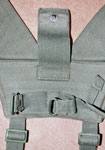
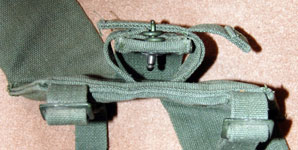 Far left - Below, a length of ¾-in. strapping had a link at each end and the web part of a Q.R. fastener. The T-handle of the Lightweight shovel was positioned so that the 2-in. strap was folded over, the spigot (the male half of an LTD fastener) then being fitted into a corresponding hole on the shovel helve. The links on the ¾-in. strap ends then fitted over a staple on the outside of the 2-in. strap. As well as the shovel, the helve of the Lightweight pick could be similarly fitted. The Fitting Instructions recommended that a sandbag was to be wrapped around either helve, to act as padding for the spine. The maker of this 1962 example is unknown.
Far left - Below, a length of ¾-in. strapping had a link at each end and the web part of a Q.R. fastener. The T-handle of the Lightweight shovel was positioned so that the 2-in. strap was folded over, the spigot (the male half of an LTD fastener) then being fitted into a corresponding hole on the shovel helve. The links on the ¾-in. strap ends then fitted over a staple on the outside of the 2-in. strap. As well as the shovel, the helve of the Lightweight pick could be similarly fitted. The Fitting Instructions recommended that a sandbag was to be wrapped around either helve, to act as padding for the spine. The maker of this 1962 example is unknown.
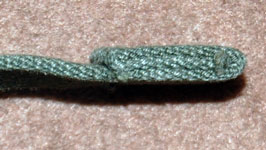 The front strap ends are stiffened by being folded over twice and stitched.
The front strap ends are stiffened by being folded over twice and stitched.
Stores Ref. CN 8465-99-120-7160 YOKE, FIELD PACK, Modified [Issue 2]
Stores Ref. CN 8465-99-120-7160 YOKE, FIELD, PACK [Issue 2]


 In what the Army dismissed as “…modified…”, only a simple change was made to the Yoke, two transverse loops being added to the rear of the flares. This was to locate the suspension straps of the Pack more securely, as they were passed through the loops. The punctuation of the second title is incorrect! Maker marked "O.W.L." and dated 1985. From Terry Hawker Collection. Photographs © Terry Hawker, 2012.
In what the Army dismissed as “…modified…”, only a simple change was made to the Yoke, two transverse loops being added to the rear of the flares. This was to locate the suspension straps of the Pack more securely, as they were passed through the loops. The punctuation of the second title is incorrect! Maker marked "O.W.L." and dated 1985. From Terry Hawker Collection. Photographs © Terry Hawker, 2012.
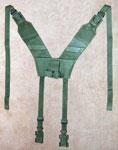
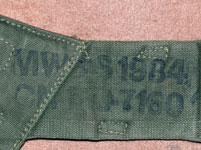 This late production and mint example has M.W. & S. stencilling in their massively larger style. From the Rog Dennis Collection. Photographs © Rog Dennis, 2012.
This late production and mint example has M.W. & S. stencilling in their massively larger style. From the Rog Dennis Collection. Photographs © Rog Dennis, 2012.
Stores Ref. CN 8465-99-973-6847 BRACE ATTACHMENT
Stores Ref. CN 8465-99-973-6847 YOKE, BELT ATTACHMENT
 First listed in the 1965 Fitting Instructions, as a “Brace attachment” (which it was not), this item was necessitated when Ammunition pouches were not worn, e.g. with a Binocular case, which had no metal yoke loop. They were actually the “C” hook pads from the rear straps of the Yoke, normally inseparable from the Yoke, but here made as discrete items and coded. From the Rog Dennis Collection. Photographs © Rog Dennis, 2012.
First listed in the 1965 Fitting Instructions, as a “Brace attachment” (which it was not), this item was necessitated when Ammunition pouches were not worn, e.g. with a Binocular case, which had no metal yoke loop. They were actually the “C” hook pads from the rear straps of the Yoke, normally inseparable from the Yoke, but here made as discrete items and coded. From the Rog Dennis Collection. Photographs © Rog Dennis, 2012.
Rog Dennis 2012